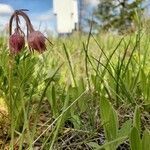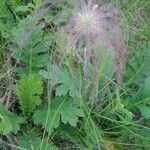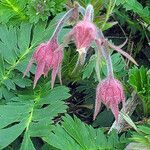Stems 2–4 dm from a short, stout rhizome, hairy throughout; basal lvs 1–2 dm, oblanceolate, pinnately compound; lfls 7–17, the lateral progressively larger toward the lf-tip, cuneate-oblong, to 5 cm, irregularly laciniate or lobed, the terminal one similar but wider, often confluent with the upper lateral ones and scarcely larger than them; cauline lvs few and small, laciniate; peduncles eventually to 1 dm; fls nodding, broad-based, narrowed distally in life; sep shorter than the linear bractlets; pet purplish, 8–12 mm, about equaling the bractlets, suberect; mature styles 3–5 cm, strongly plumose except the terminal 2–5 mm; 2n=42. Dry woods and prairies; w. N.Y. to Minn. and Io., w. to B.C. and Calif. May, June. Our plants are var. triflorum. (Sieversia t.)
A stout herb. It is tufted and has a woody rootstock. It keeps growing from year to year. The leaves are mainly at the base. The leaves are feather like and divided into leaflets along the stalk. They are 15 cm long. They are grey-green and can be downy. The flower stems are 20-40 cm long. There are a cluster of yellow flowers with a maroon tinge.



